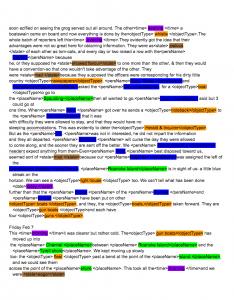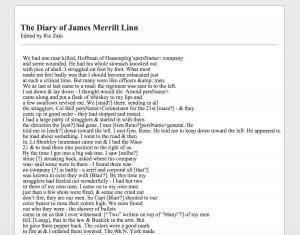Using close reading as a tool to analyze the transcription helped us to better understand the text. In class, we have used two tools/techniques, categorizing words by colors and TEI. Both of which were very useful, especially TEI, in categorizing important words. By tagging words, we analyzed every bit of information they might offer. Pierazzo stated “no transcription, however accurate, will ever be able to represent entirely the source document” (Pierazzo, 464). Although we can’t represent it entirely, we can at least get every bit of information we can.
 Categorizing words by colors was a very interesting technique. It is simple yet efficient in highlighting significant words. We tagged words by categories (people, places, events, traits, states, etc.) and highlight them in different colors. As simple as it sounds, we encountered a lot of problems. We had to define what is and what isn’t tag-worthy. The categories were a problem themselves. We had many arguments on what should be in which category. For example, we had to define whether “Cossack” should be a place or an object. Like “Cossack”, many words were on the verges of two different categories. Overall, it was interesting to see how everyone chooses to tag and how Linn chooses to write down his observations. There were more tagging for people and objects than anything else. Linn seems to be more concerned with physical things.
Categorizing words by colors was a very interesting technique. It is simple yet efficient in highlighting significant words. We tagged words by categories (people, places, events, traits, states, etc.) and highlight them in different colors. As simple as it sounds, we encountered a lot of problems. We had to define what is and what isn’t tag-worthy. The categories were a problem themselves. We had many arguments on what should be in which category. For example, we had to define whether “Cossack” should be a place or an object. Like “Cossack”, many words were on the verges of two different categories. Overall, it was interesting to see how everyone chooses to tag and how Linn chooses to write down his observations. There were more tagging for people and objects than anything else. Linn seems to be more concerned with physical things.![]()
TEI changes the way we can analyze text.Similarly to the colorization technique, TEI allows us to categorize words with a variety of options. With the help of TEI, we have endless options in tagging significant words. In Pierazzo’s article, Dristol stated “to all intents and purposes there is no limit to the information one can add to a text—apart, that is, from the limits of the imagination” (466) when commenting on the possibilities of TEI. While encoding with TEI, I had a lot of problems with deciding how many different codes I needed to analyze a word. We had a lot of options but we also had a lot of words. With TEI, I found myself tagging more words than with the colorization. I tagged a lot of words that were not significant. However, by tagging them, I was able to learn everything we could from the physical states of the object to the time and place.
The collaborative process works in our advantage. As we were able to work with each other, we made sure that we had the same guidelines for tagging these words. Pierazzo said that the opinion of the editor changes the interpretation of the transcription. By deciding on the tagging of certain words, we can have similar interpretation of the text, therefore prevents us from deviating from the accepted guideline.









